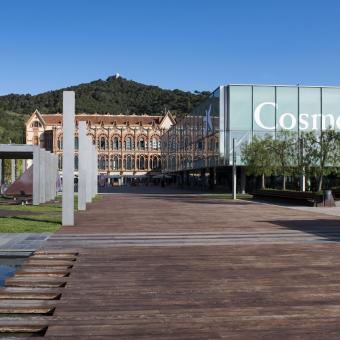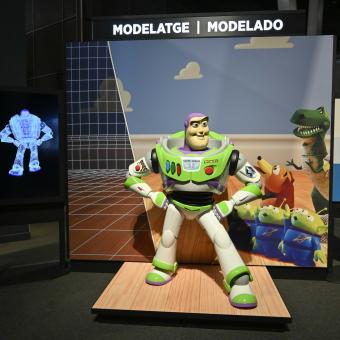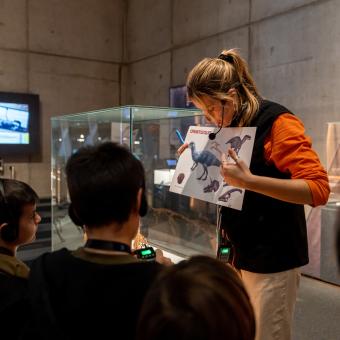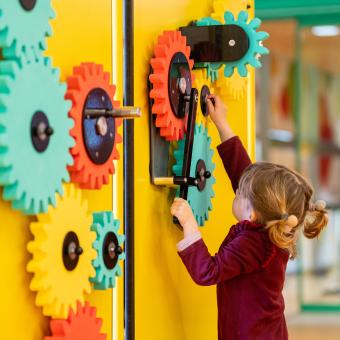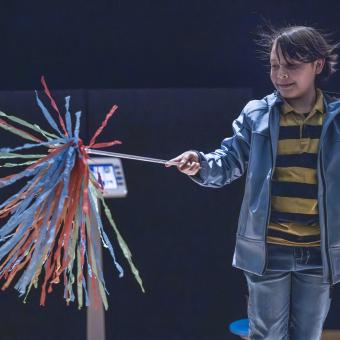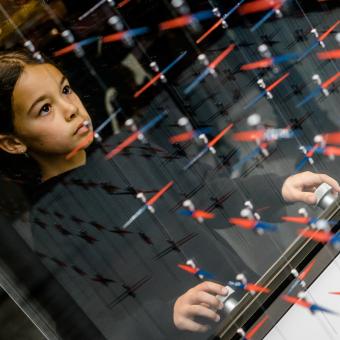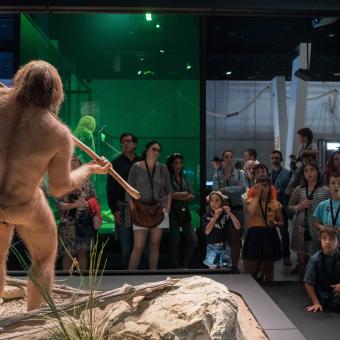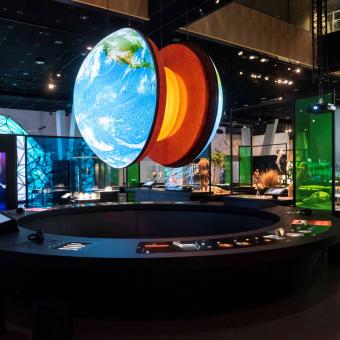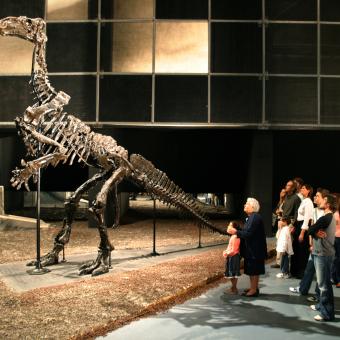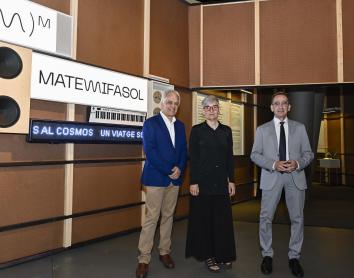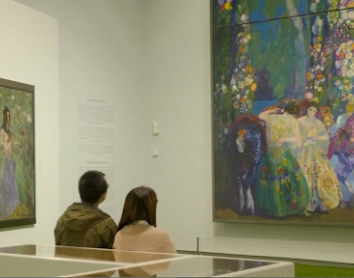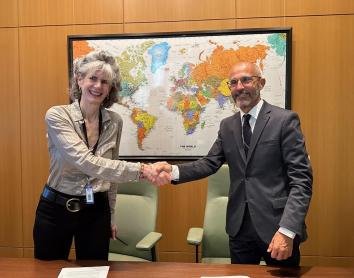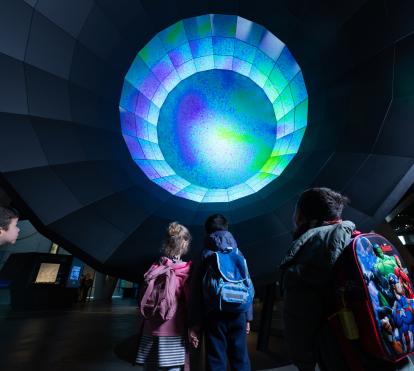
CosmoCaixa celebrates its 20th anniversary with over 16.5 million visitors
16.09.24
8 minutes readIn its two decades of existence under the name CosmoCaixa, the ”la Caixa” Foundation’s centre dedicated to scientific outreach and the promotion of scientific vocations has hosted 52 exhibitions and over 4,200 different activities for all audiences. To commemorate this milestone, the museum is organising an open day on Sunday, 6 October and scheduling nine free sessions, with prior reservation, of a new projection at the Planetarium: Dark Biosphere. Since the inauguration of the expanded museum in 2004, CosmoCaixa has established itself as the leading science museum in Spain, one of the most outstanding in Europe and among the most modern on the international scene.
The CosmoCaixa Science Museum is celebrating 20 years of history this year and has established itself as the leading science museum in Spain, one of the most outstanding in Europe and among the most modern in the world, thanks to its commitment to offering an educational experience through interaction and entertainment. Its goal is to bring science closer to all audiences, inspire scientific vocations among young people and highlight scientific advancements to society. During this period, more than 16.5million visitors have passed through the centre, enjoying 52 exhibitions and over 4,200 different activities.
To celebrate this milestone, the museum will organise an open day on Sunday, 6 October, with free admission and nine sessions, also free but with prior reservation, of the new Planetarium projection, Dark Biosphere, which was presented with the Best Movie Award at the prestigious Fulldome Festival Brno (Czech Republic). Directed by the geologist and filmmaker Javier Bollaín, it takes visitors on a journey from the Earth’s core to the far reaches of our galaxy, encouraging them to rethink the origin and evolution of life and its possible existence throughout the universe.
A legacy of more than four decades bringing science closer to society
Although CosmoCaixa is celebrating its 20th anniversary, the history of the Science Museum of Barcelona from which it evolved dates back 43 years to 1981, when it opened as the first interactive museum to be created in Spain. From the outset, the space has worked to ensure that science is regarded as part of culture and becomes a tool for social transformation, as well as to raise awareness in society about environmental issues.
With this aim, it offers a comprehensive and innovative programme, featuring a wide variety of workshops, lectures, courses, performances, screenings, guided tours and interactive exhibitions. The museography is conceived to provide a multisensory experience, allowing visitors to be active participants in their visit through interaction and first-hand involvement, making learning memorable. The offerings are aimed at all audiences: families, children, young people and educational centres, as well as specialised audiences, disadvantaged groups and people at risk of social exclusion.
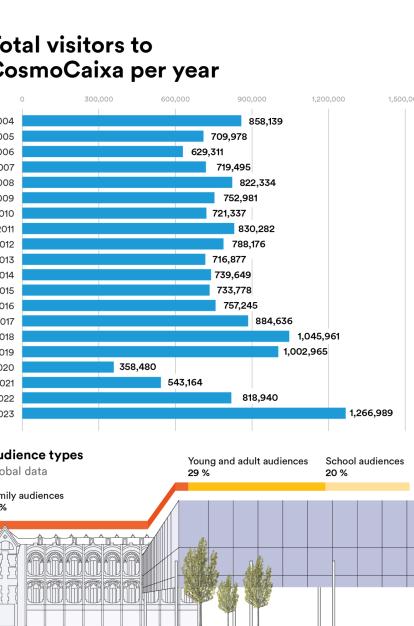
Over these 20 years, of the more than 16.5 million visitors who have immersed themselves in the museum’s initiatives, 69.8% have come from the province of Barcelona, 6.4% from the rest of Catalonia and 8.8% from the rest of Spain, while 14.9% have been international visitors. Some 51% of visitors report having attended with their families. Additionally, the extensive scientific offering aimed at schools has attracted more than 3.4 million students and school groups, who have learned fromand enjoyed the centre.
CosmoCaixa’s diverse programming, with initiatives of high quality and value, has been key to establishing it as a reference point in the city. In fact, last year it broke its historical attendance record, with over 1.2 million visitors (50% more than in 2022), and became the ”la Caixa” Foundation’s most visited centre.
In the words of the director of the CosmoCaixa Science Museum, Valentí Farràs: “CosmoCaixa is much more than a museum; it’s a space where multiple generations of visitors have grown up discovering the magic of science. For many, this museum holds childhood memories and is where their curiosity about the world around us was sparked. Over these 20 years, we have worked to offer an experience that is both educational and enjoyable, thus promoting learning in an inspiring and motivating environment. Our commitment is to continue being a reference in scientific outreach, adapting to the times and incorporating the latest innovations to keep on captivating and educating future generations.”
A living space in constant adaptation
In a continuous process of improvement, the centre has been progressively adapting to visitors, incorporating the latest scientific updates and thereby stimulating scientific curiosity across more than 30,000 m2 of facilities dedicated to outreach. Including the outdoor spaces (Science Square, the Pine Garden and the Mediterranean Garden), CosmoCaixa reaches a total of 55,000 m2 of space dedicated to science, culture and leisure.
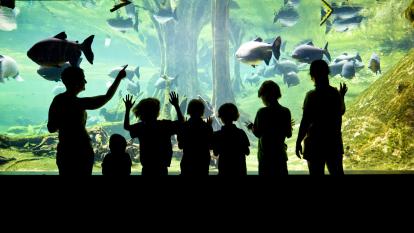
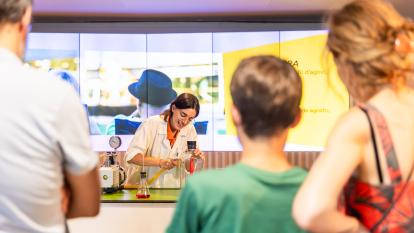
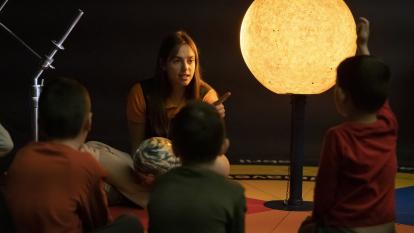
Among the permanent spaces on offer, one of the museum’s icons is the Flooded Forest, which recreates a 1,000 m2 fragment of the Brazilian Amazon rainforest. The recently renovated Clik creates an educational environment for scientific experimentation for the youngest visitors, with modules dedicated to air, light, water, construction and mechanics. The Planetarium opens a window onto the cosmos to learn about the universe through full-dome projections. The Micrarium lets visitors explore the microscopic world and observe what is invisible to the human eye by experimenting with different magnifying instruments. These spaces are complemented by the Bubble Planetarium, designed to introduce young children to the world of astronomy; Creactivity, which encourages creativity through the manipulation and assembly of objects and materials; and the Math Lab, where visitors can engage with mathematics in a different way through challenges, riddles and puzzles.
Recently, in 2019, the major renovation of the Hall of Matter transformed it into the Universe Hall, a 3,500 m2 exhibition area that allows visitors to take a conceptual journey from the Big Bang to the very latest frontiers of knowledge.
52 exhibitions: The Iguanas, the most visited
Over the years, the temporary exhibition hall has hosted displays ranging from current affairs to social issues, with an emphasis on science and the environment. Among the most visited are the inaugural show of the new CosmoCaixa, The Iguanas (1,695,365 visitors), which remained in the museum for 21 months, followed by Top Science (1,463,195) and Good Family Numbers (703,912).
On the other hand, the most recent exhibitions, The Science behind Pixar and Dinosaurs from Patagonia, broke records for daily visitors, with an average of 3,900 and 2,800, respectively.
In recent years, the ”la Caixa” Foundation has promoted an increasingly efficient model for the distribution of exhibitions, allowing shows initially created for CosmoCaixa to be displayed in CaixaForum centres across Spain. Additionally, travelling versions have been created for cities without their own centres, in order to reach a broader audience. These exhibitions are also exported internationally through agreements with Ciência Viva (Portugal) and the American Museum of Natural History in New Work.
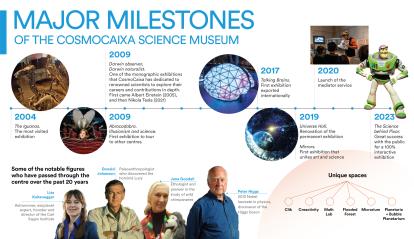
Epicentre of scientific figures and international recognition
Beyond being a science museum, CosmoCaixa has also become a meeting point for science and society, a place for conversation, debate and reflection. It often hosts lectures by prominent scientific figures, including the Nobel Prize winners in Physics Peter Higgs, Donna Strickland, Serge Haroche and Michel Mayor; the ethologist Jane Goodall; astrophysicists Jocelyn Bell Burnell and John M. Grunsfeld; astronauts Luca Parmitano and Terry Virts; the astronomer and director of the Carl Sagan Institute, Lisa Kaltenegger; and Nobel Prize winners in Medicine Erwin Neher and Richard Roberts, among many others. It also holds scientific conferences and organises major events such as the Live Research Fair, Science Week and the Night of Research.
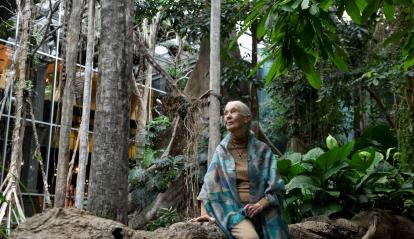
Over the years, CosmoCaixa has garnered several significant recognitions. In 2006, it was awarded the prize for Best Museum in Europe (EMA). In 2021, the centre was honoured with the prestigious Kenneth Hudson Award at the European Museum of the Year Awards (EMYA) for its capacity for reinvention and its contribution to society. Two years later, in 2023, it received the National Award for Scientific Communication, granted by the Government of Catalonia through the Catalan Foundation for Research and Innovation.
Iconic institution
The original idea for the Science Museum emerged in 1977, when the Obra Social [Social Work] of the Caixa de Pensions per a la Vellesa i d’Estalvis identified a gap in the cultural offerings related to science and technology, in contrast to the well-established focus on the humanities and arts. Motivated by this observation, the concept of a centre dedicated to bringing scientific knowledge closer to the public began to take shape. The building, originally constructed in 1904 by the modernista architect Josep Domènech iEstapà as a facility for the blind, which had operated for 75 years, was remodelled and expanded by architects Jordi Garcés and Enric Sòria to become the Science Museum of Barcelona, which opened its doors in 1981.
Years later, towards the end of the 1990s, with the aim of offering the public a science museum that met the expectations of the impending turn of the century and responding to the increasing number of visitors, another major transformation was undertaken. Over five years, the original modernista building was integrated with the current space of the CosmoCaixa Science Museum, which was finally inaugurated on 24 September 2004.







